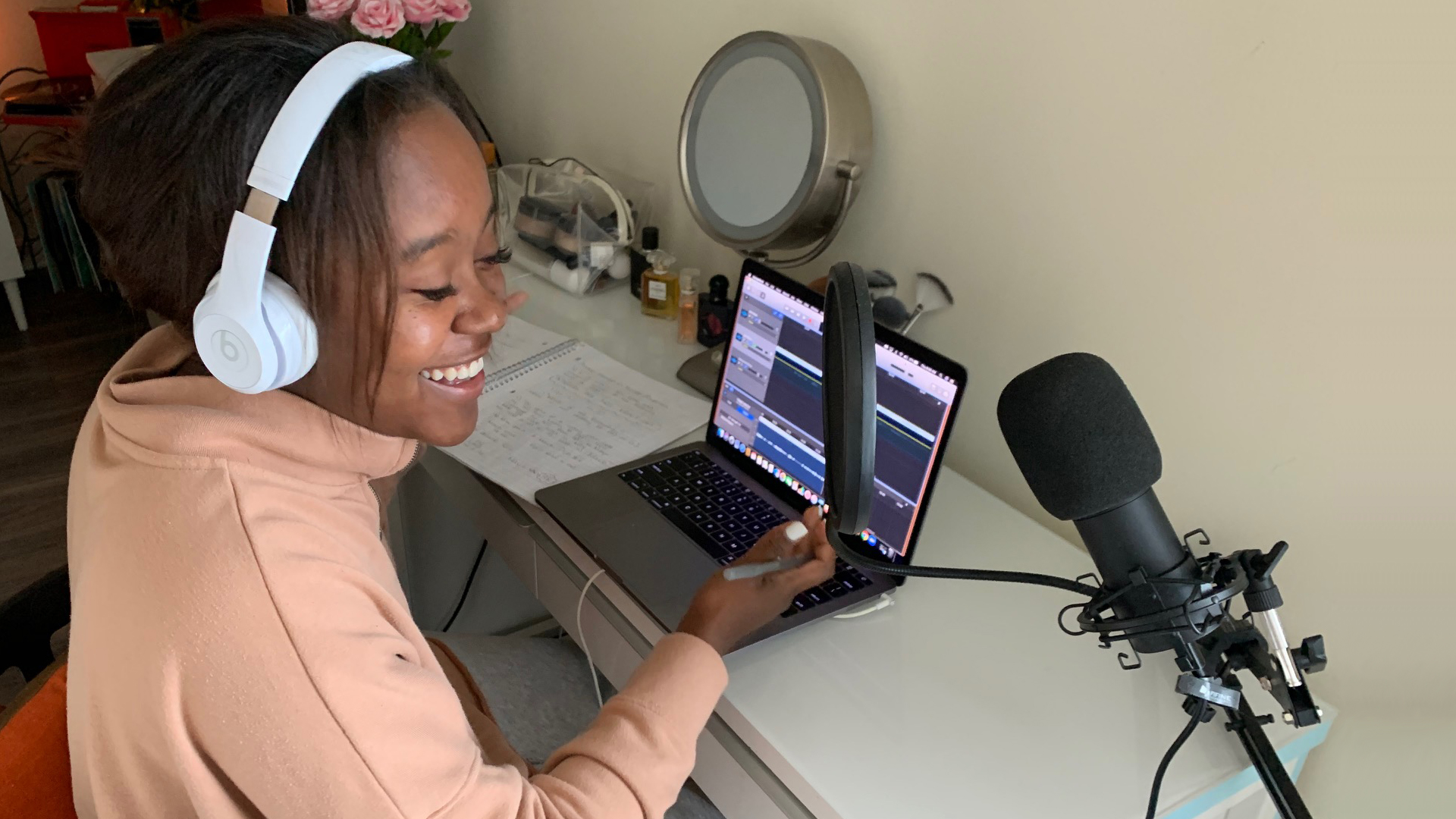
UD student Shay Smith recording her podcast "Shay Says," which offers different perspectives on cultural myths and mental health.
The Power of Podcasting: Conversations that Create Community
By Allison Ebner
Whether you’re living with family, friends or just your cats during the pandemic, it can be nice to hear from a different voice on occasion.
Podcasts provide us with opportunities to connect with others, fostering a sense of personal connection through the power and intimacy of one’s voice. They can provide an escape, a touchpoint with the world outside, and a sense of community—and not just for the listeners.
Librarian Amanda McCollom, our resident audio expert in the Student Multimedia Design Center (SMDC), is no stranger to supporting students, faculty and staff in the creation of podcasts.
As the UD community has stayed at home to flatten the curve, some have embraced the creativity and excitement of making a podcast using equipment they had at home—along with free resources, tutorials and guidance from experts like Amanda.
Explore a couple of those stories below, and, if you’re feeling inspired, dive into a few quick tips from Amanda on how to get started with your own podcast.
Podcasting for Fun
In a way, rising senior Shay Smith has the quarantine to thank for “Shay Says,” her podcast that offers different perspectives on cultural myths and mental health. While she first had the idea two years ago, the quarantine allowed Shay to commit the time to the project. It also provided the opportunity to contribute reliable information on how people with mental health issues are handling the quarantine.
Each 13-minute episode of “Shay Says” builds on the one before it, taking listeners on a journey from the basics of self-esteem to heavier topics about mental health. Shay, who plans to pursue her doctorate in counseling psychology after graduating from UD in 2021, guides her audience through this journey and is joined by experts in the field, including UD professors and clinicians at the Mid-Atlantic Behavioral Health in-patient practice where Shay interned.
Early on, she reached out to Amanda for guidance. After a 45-minute consultation over Zoom where Shay was able to ask Amanda all the questions she had, Shay turned to Tools for Podcasting—an online, open textbook on podcasting that Amanda recommended—and hit the ground running.

You can listen to Shay’s podcast “Shay Says” on iTunes, Spotify and SoundCloud now. Artwork by Nathan Hissong.
She bought a microphone to ensure the best audio quality, and began reaching out to experts and researchers to appear in episodes. She defined her audience–her peers, ages 18-24—and kept them in mind as she scripted each episode, breaking down the language so they could understand psychology without any background in the field. She kept her episodes under 15 minutes to accommodate shorter attention spans, left room in her scripts for natural conversation with guests, and used GarageBand to edit everything together.
While the end-result is seamless—complete with artwork by friend Nathan Hissong and music by friend Frank Ziegler—Shay brought a lot of hard work and passion to make all the layers come together.
Podcasting for Class
In Integrated Biology and Chemistry, an introductory course and lab for 300 life science majors a semester, a podcast assignment has been a staple for the past four semesters. While the mid-semester switch to remote learning changed many assignments across campus, the podcast assignment was easily adaptable.
Working in groups of three, students chose their own topics and researched the subject using news articles. With that research, they scripted and recorded a podcast with one student serving as host and the other two as subject experts. When they were unable to record together in person this past semester, students turned to Zoom—a platform they already knew how to use that provides an audio-only file of a recording.
Through the assignment, students learn how to communicate their research in an accessible way. “They should really know how to communicate [scientific information] to the public, because we’re just seeing more and more need for that, especially now with COVID-19,” said Professor Stefanie DeVito.
Professor DeVito and preceptors Anne McDuell and Jennifer Sykes provided the students with activities to encourage them to think through how best to communicate their research, like identifying how other podcasts facilitate breaking down scientific jargon. This semester, the instructors also used Amanda’s Podcast Planning Worksheet, which helps students think through and outline the purpose, audience, structure and tone of their podcast.
Many students embraced the creativity of this project—designing cover art, adding background music and learning the audio software Audacity even though it didn’t earn them extra points—and were excited to share the end-result.
Listening to their classmates’ podcasts is a fan-favorite aspect of the project for students, Professor DeVito explained. This semester, the students peer reviewed some of the submitted podcasts of their fellow classmates. While this portion of the assignment reinforced the concepts students learned in creating their own podcasts, it also helped foster a sense of connection between classmates despite being physically apart.
Podcasting on Your Own
Do you have a story to tell, conversation to start or new perspective to share? Podcasting could be the right outlet. Here are a few tips from Amanda to help you get started:
1. Listen to other podcasts.
Pay attention to the formats they use, and elements you like or dislike about them. Doing this will help you determine the type of podcast you want to create.
2. Know your audience.
When you identify who will be listening, you can determine what they already know about your topic and work to ensure you are speaking their language, breaking down jargon and terminology they don’t know.
3. Plan and practice.
Brainstorming the purpose, structure and content of your podcast is essential. If your podcast is scripted, you’ll want to practice delivering the script for the ear—reading a typical paper won’t necessarily translate to an engaging podcast without some tweaking. Even if your podcast is conversational, outline the key points you want to hit in advance to ensure you get to them when you’re recording.
4. Be aware of your surroundings.
When recording, try to avoid areas with large open spaces, lots of windows and distracting ambient sounds. It should sound like you’re in the same room as the listener. Test your audio levels until they are where you want them—not too loud or soft—so that you don’t need to do extensive editing. Fun fact: Many podcasters record in their closets when they’re starting out.
5. Work with what you have.
You can still record a quality podcast without recording equipment from the SMDC. Phones can record good audio as long as they are close enough to the person speaking. Headphones with a built-in microphone will sound better than a computer microphone alone.
6. Record with Zoom.
The video conferencing platform works well for recording podcasts with multiple speakers. It allows you to save the recording as an MP4 video file and an M4A audio file.
7. Use music to establish tone.
Is your podcast lighthearted, comedic, serious? Music is a great way to convey the mood and tone of your podcast. You can find free Creative Commons licensed music to use at Free Music Archive.
8. Take advantage of free resources.
Use Audacity, a free software available for Windows and Mac, to edit your podcast—you can check out Amanda’s tutorial to get started. Turn to Tools for Podcasting, an open textbook available online that provides practical guidance and best practices for the entire podcast process, including information on how to launch and promote your podcast. And, of course, we encourage you to schedule a consultation with SMDC staff, who can answer questions related to podcasts, audio recording and audio editing.
